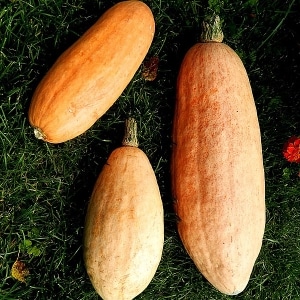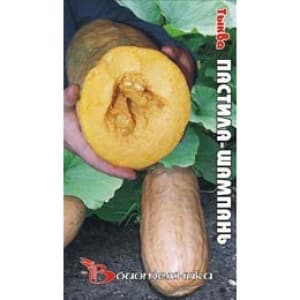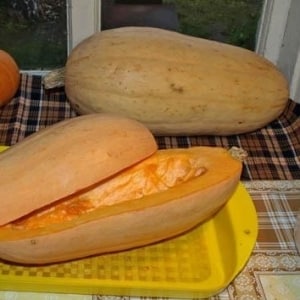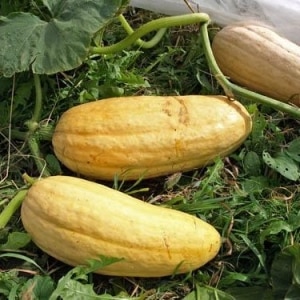A fleshy and light variety of pumpkin “Pastila Champagne” with juicy pulp and a unique aroma
This pink vegetable has a bright vanilla aroma, unusual appearance, long shelf life and unpretentious character. We are talking about an extravagant variety of pumpkin with the beautiful name Pastila Champagne.
We'll tell you everything about this crop: its cultivation features, the secrets of a good harvest and its application. And at the end of the article you will find reviews from farmers who have already managed to grow this vegetable.
Description and characteristics of the variety
Pumpkin Pastila Champagne is a mid-season variety. The bush of the plant is medium in size and occupies a small area on the site.
Distinctive features
Pastila champagne pumpkin differs from other varieties in its unusual shape and color. This can be seen in the photo. The fruit is divided into small segments, with light spots on the skin. Another distinctive feature of the variety is that it tolerates transportation well over long distances and is stored for a long time without losing its presentation and taste.
Fruit characteristics
 Pastila champagne pumpkin fruits are elongated in the shape of an ellipse. The weight of one pumpkin is 2-3 kg. The peel is dense, but not thick-walled, and has a pinkish tint.
Pastila champagne pumpkin fruits are elongated in the shape of an ellipse. The weight of one pumpkin is 2-3 kg. The peel is dense, but not thick-walled, and has a pinkish tint.
The pumpkin pulp is fleshy, bright orange in color with a pleasant vanilla aroma, and tastes sweet. The seed chamber is located along the entire fruit, it is deep, but seeds small.
Productivity
The yield of the variety is average. With proper care, you can collect 3-4 pumpkins from one bush.
How to grow
For a good pumpkin harvest, it is important to choose the right place to plant it.And then carry out the appropriate measures to care for the plant. The first important stage is the preparation of seed material.
Seed preparation
First, pumpkin seeds are heated near a heating device (for example, on a radiator) for a month. This increases the chance of getting more female flowers, which means growing a larger crop.
Next steps:
- Seeds are selected and empty ones are thrown away. To determine whether they are empty, place the seed in a salt solution. Those that do not drown are empty and not suitable for planting.
- The seeds are hardened. The seed, wrapped in a damp cloth, is kept in the refrigerator for three days. This will help the seedlings adapt more quickly to weather changes.
- Disinfection is carried out. Before planting, the seeds are soaked for 10 hours in a weak solution of potassium permanganate or water with aloe juice.
Landing
Most gardeners plant this variety of pumpkin directly in the ground without first growing seedlings. The best time to plant seeds is the end of May. Choose a sunny place for the plant, sheltered from drafts.
If there is a desire or the weather conditions of the region are unfavorable, seedlings are grown. This is done at the end of April, and by mid-May they are transferred to the ground under a film. The plant is watered abundantly immediately after planting. The film is removed after 3-4 weeks.
The seeds are germinated before planting. To do this, soak them in water for 2-3 hours, then lay them out on a wet cloth and cover. Leave for 3-4 days. After this procedure, sprouts will appear from the seeds, and they can be planted in separate containers, deepened into the soil by 5-7 cm. Peat pots are well suited.
Scheme for planting sprouts in the ground: 1.5 x 1 m (distance between rows and plants, respectively). First, 5-6 kg of humus and 2 tbsp are added to each hole. l.organic fertilizer. The culture grows well on compost heaps.
Read also:
Why is the Marble pumpkin so popular among farmers?
The benefits and harms of steamed pumpkin: steam the vegetable and use it correctly.
Care
When caring for this variety, it is important to maintain regular watering. Start with a small amount of water (2-3 l), gradually increasing it as the plant grows (up to 10 l). Watering should be done under the seedling. When the fruits reach their maximum size, stop watering, otherwise the vegetables will be tasteless and may rot.
Feed the plant 2 times a month. Cow manure and a complex of organic fertilizer in equal proportions are suitable for this. You can fertilize the crop with these products until the end of July. From August onwards, it is better to use only fertilizer containing potassium. It helps the fruits ripen faster.
Features of cultivation and possible difficulties
Champagne marshmallow weaves well, so before the fruits begin to set, you can install a net nearby. The scourges will climb on it.
Excess ovaries are removed so as not to overload the lash. Leave 4-5 pieces, which are tied with twine.
There are times when Champagne Pastille does not grow due to an incorrectly selected planting site. Due to the lack of sufficient heat and light, the plant may not produce a harvest at all.
Growing tips from vegetable growers
Growing and caring for pumpkins has its own peculiarities. To get a good harvest, experienced gardeners recommend:
- Carefully select and prepare seed material.
- Follow the rules of crop rotation: plant a pumpkin in the same place only once every 3-4 years.

- Do not cultivate melons (zucchini, melons, cucumbers) nearby.
- Maintain distance between plants. Do not thicken the plantings.
- Before setting fruit, treat the plant with remedies against diseases and various pests.
- Weed regularly. They contain fungal spores that cause bacteriosis.
- Feed the pumpkin with complex mineral fertilizers (copper sulfate, boric acid with urea, potassium permanganate, zinc sulfate).
- Regularly inspect plantings for diseases and pests.
- Promptly remove infected plants and fruits.
- Pinch the main stem of the pumpkin when it reaches 1.5 m in length.
- Reduce watering in late summer (about two weeks before harvest).
Diseases and pests
Protecting a plant from diseases and pests is an important point in caring for it. Pastila champagne pumpkin has average resistance to diseases. For example, bacteriosis can destroy the entire crop. It is important to detect it immediately, preventing an epidemic.
Its first signs:
- fruits that have darkened and have already begun to rot;
- brown ulcers;
- uneven fruit growth.
If you find an infected bush, immediately remove it from the site. The remaining plants need to be treated with Bordeaux mixture.
As for pests, beware of aphids and spider mites. To prevent them from multiplying, spray the bushes with a solution of onion peels. To prepare it, pour 4 cups of husk into 2 liters of hot water and leave for two days. Then the infusion is filtered and diluted with water in equal proportions. Treat at least three times with a break of a week.
Harvesting and application
Harvesting occurs at the end of September-beginning of October. The ripeness of the fruit is checked by the stalk. In a ripe pumpkin, it hardens and begins to dry out. Pumpkins must be collected with stems, otherwise they will not be stored for long.At room temperature, Pastille Champagne can be stored for up to 3-4 months without loss of taste.
Important! The fruits should be stacked with the stalk facing up and so that they do not touch each other. For long-term storage, vegetables without damage or obvious stains are selected.
Application

This sweet vegetable is good in almost any form. It is added raw to cold appetizers and salads, and fresh pumpkin is made. Champagne pastille is baked, stewed, and various pastries, puree soups and porridges are prepared from it.
Many people will like it in combination with meat, and even just baked slices of this vegetable with sour cream or mayonnaise will be considered a delicacy. And even children love this pumpkin for its sweetness.
Advantages and disadvantages of the variety
The variety has many advantages, but there are also disadvantages. First things first.
Pros:
- pleasant taste and aroma;
- a lot of pulp;
- convenient fruit shape;
- drought resistance;
- long shelf life;
- high transportability.
Minuses:
- prone to viral diseases and pest damage;
- demanding care;
- does not tolerate high humidity and frost.
Farmer reviews
Many vegetable growers liked the Pastila Champagne pumpkin. They note its taste, versatility of use, and productivity.
Elena: “I planted 2 seeds in the ground on May 27. On two plants it was possible to grow 3 pumpkins (weighing 2, 4 and 10 kg). There were a lot of small pumpkins setting, but most likely due to the cold and wet July they were rotting. The taste of fresh pumpkin is sweetish and very pleasant, the consistency is dense, the aroma is melon-cucumber-watermelon. I liked it better raw. The peel is not hard and can be cut off quite easily. When cut, it doesn’t keep well.”

Catherine: “Nice fresh scent. Without pumpkin smell and taste. Pleasantly sweet.Both fresh and baked. On one vine, 2 pumpkins grew, 1.5 and 1.7 kg each. Not enough, but we didn’t have a summer at all, so I’m happy with that. It’s surprising that in such cold and rainy conditions the pumpkins were even sweet.”
Marina: “I try to grow Champagne Pastille pumpkin regularly, it’s my favorite variety. The length of the main lash is 4-5 meters. The weight of the largest pumpkin turned out to be 6 kg, and the smallest was about 3 kg, as stated in the annotation. The color of the fruit is beige-pink. The seed chamber is small. When ripe, it resembled a torpedo melon in appearance. Very aromatic and tasty and quite juicy for a pumpkin. I planted the seedlings on April 25 in peat pots, and in soil with shelter on May 15-17. I harvested in September.”
Conclusion
Many gardeners have appreciated the Pastila-champagne variety. Among the positive properties of pumpkin, versatility in use and long shelf life are noted.
The variety requires more care than the usual popular varieties. But all the labor costs will be paid off by the quality of the fruit. And in the right place, even with minimal care, you can collect at least three pumpkins from one bush.